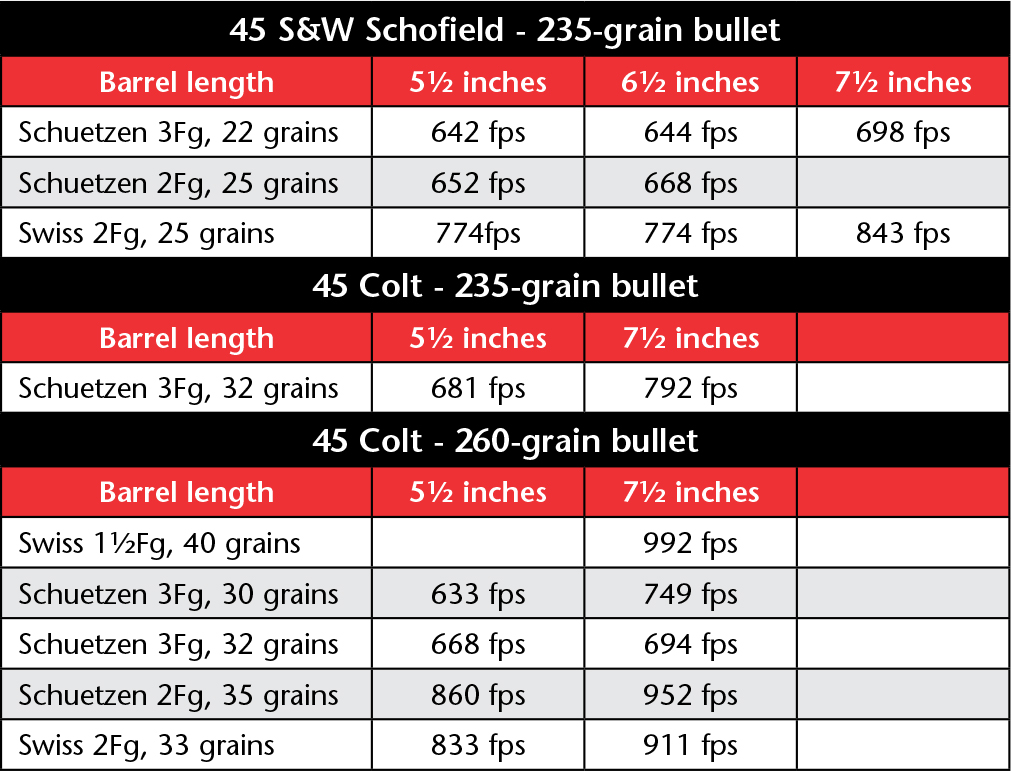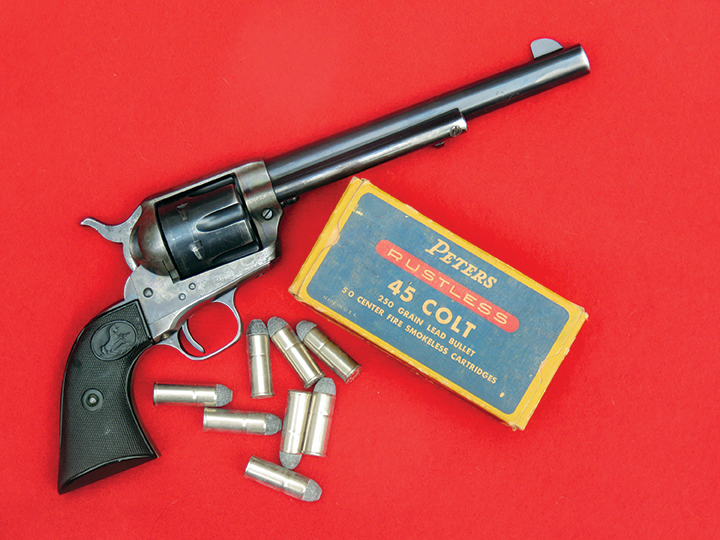
The 45 Colt still packs the power, especially with black powder.
The 45 Colt is certainly legendary. It was given a leading role in the history of our Old West, where it certainly played a big part, regardless of whether it was as much as the legends make it or not. Helping that legend was Charlie Russell’s painting from 1908, called “Smoke of a .45” which depicts a gunfight where the 45 Colt looks to have played a leading role. The big .45 was our most powerful revolver cartridge from its introduction in 1873, right up to the mid-1930s, when it was surpassed in power by the ear-shattering 357 Magnum. While the new magnum revolvers do outclass the old .45 in almost every area, the 45 Colt is still our most powerful black powder revolver cartridge.
In the early 1870s, there was a demand by the U.S. Army for a new revolver cartridge. The two that were tried in 1871, the 44 Colt and the 44 Smith & Wesson American, led the way but the Army requested a more powerful revolver. The Colt Patent Firearms Company answered that request with the 45 Colt, shooting a 250-grain bullet propelled by 40 grains of black powder. That’s a handful, and it turned out to be more than what the Army had expected. So, the Army had the loading reduced to 28 grains of powder, which was the same for the 45 Smith & Wesson used in their Schofield Model.
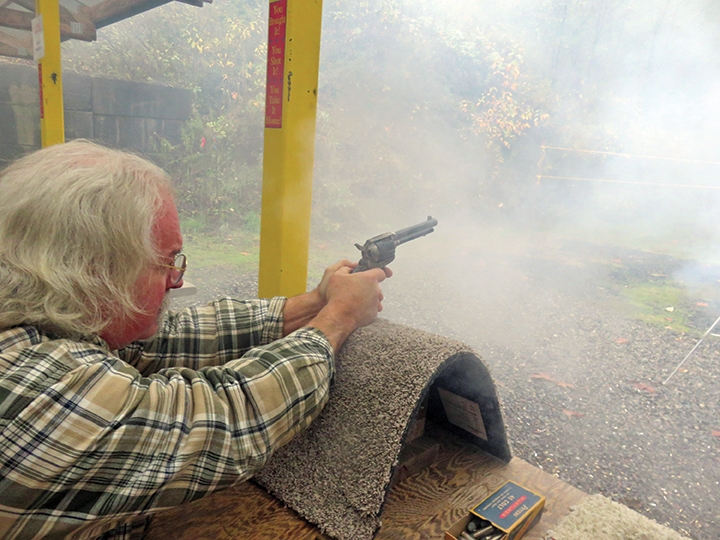
“The Smoke of a .45” hangs heavy with black powder loads.
Years ago, I knew a man named Ira Craker, who claimed that he was a U.S. Deputy Marshal in 1905, assigned to the Yakima, Washington, area. When he was in his mid-90s, he told me about some of his experiences, but what I remember most were his guns. For a sidearm he carried a Single Action Army with a 7½-inch barrel in 32-20 caliber because he didn’t like the recoil of the bigger guns, especially the 45 Colt. His rifle was one of Winchester’s Model 1894s in the rather new 32 Winchester Special. Craker claimed that his 32 W.S. had a 36-inch barrel but I have always assumed he meant a 26-inch barrel, although Winchester did make some very long barrels on special order. I relate this part of Craker’s story simply to show that not everyone favored the big .45.
That reminds me of another story, which I have only heard. A Texas Ranger was on the stand many years ago where he was defending himself on the justification of his killing a wanted criminal. The attorney questioning him was trying to expose him as a wanton killer. The attorney asked, “Why do you carry a .45?” The Ranger quietly replied, “Because they don’t make a .46!”
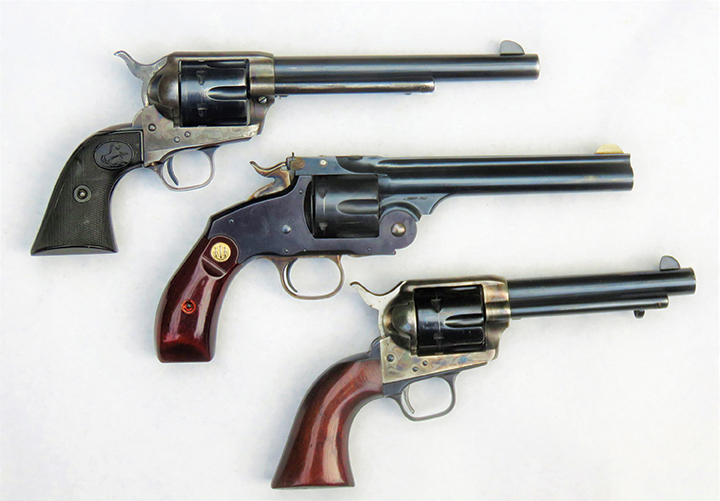
The three revolvers mainly used for our testing were my old 45 Colt with the 7½-inch barrel, an Uberti No. 3 in 45 Colt with a 6½-inch barrel and Jerry’s .45 with the 5½-inch barrel.
My own experience with the 45 Colt covers about 60 years, but I admit that most of my shooting was done with smokeless ammo. While I did use my old .45 (which I got new 60 years ago) for gathering part of the data that will be revealed in just a bit, my interest in shooting black powder loads in the 45 Colt has only surfaced rather recently. A couple of other guns, belonging to friends of mine, will be introduced in this story, as well as the Uberti “Frontier” No. 3 New Model in 45 Colt. It will be primarily used with the 45 Smith & Wesson casings and loads.
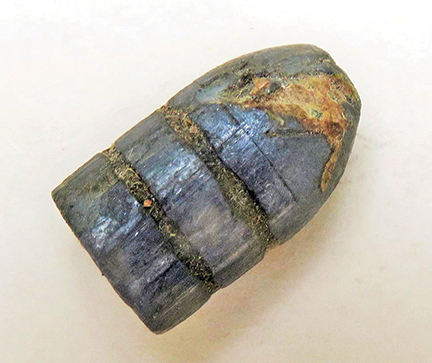
This is the bullet taken from the deer, with a small piece of bone showing.
My 45 Colt Single Action, which is a second-generation gun, was with me when I got my first deer. The actual hunting was done with a rifle, a 300 Savage, but the 45 Colt was used to administer the final round to the downed animal with a shot in the neck. That was done with a factory load and the bullet broke the spine but did not exit out the other side. I still have that bullet.
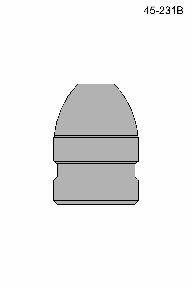
This shop drawing of #45-231B is from Accurate Molds.
Now, in our look at new black powder loads for the 45 Colt and the 45 Smith & Wesson, we’ll be using modern brass cases from Starline and black powder from either Schuetzen or Swiss in various granulations. For bullets, the standard Lyman No. 454190 will be used plus a lighter 230-grain bullet style, No. 45-231B, from Accurate Molds. My old Lyman mould for No. 454190 dropped bullets that weighed 260 grains with the soft alloy we used (about 25-1, lead to tin) and bullets from the Accurate mould weighed 235 grains. Helping me with the shooting were Bob DeLisle and Jerry Mayo, two of my pals from the Black River Buffalo Runners. We actually did quite a bit of shooting before settling down and taking notes about our gun, loads, and performance. When we finally got organized, the first load we recorded used the 235-grain bullets in the 45 Colt from the Accurate mould over 32 grains of Schuetzen 3Fg.
Those bullets were also tried in the 45 Schofield over just 22 grains of the Schuetzen 3Fg powder and fired in the Uberti copy of the New Model No. 3 S&W. I should mention how in the Old West the old Schofield cartridges had larger rims than the 45 Colt cases, mainly to help with the S&W’s extractor. Those wider rims, so I’ve heard, prevented the old 45 S&W ammo from being used for full cylinders in the Colt Single Action revolvers as only every other chamber could be loaded. With the rims on the Starline 45 Schofield cases we encountered no such problems in using the shorter .45 cartridges in our Single Action Colts or their copies. However, the 45 Schofield cases do require a different shell holder than the 45 Colt for reloading. The actual performance of those first loads will be mentioned in just a bit as there are some highlights to get out of the way first.
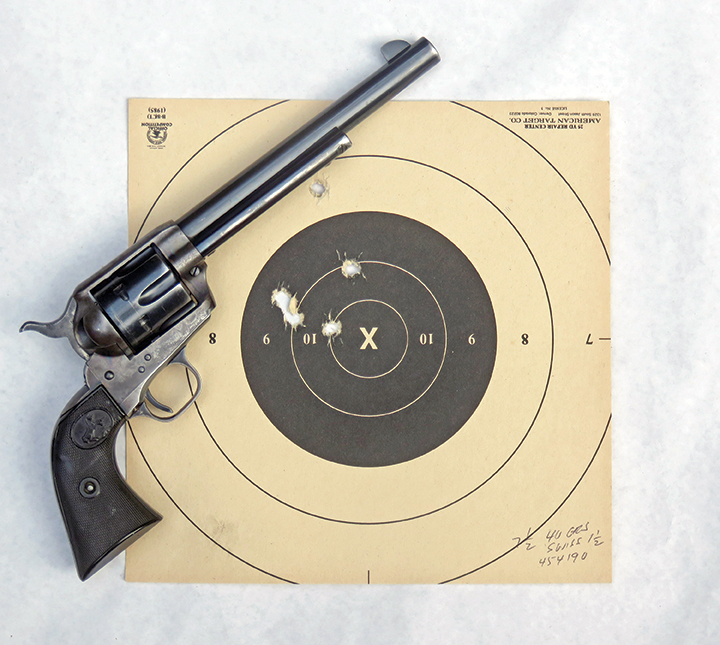
The 40 grain loads using Swiss 1½Fg were accurate.
One box of factory ammo for the 45 Colt was partially used and this requires some explanation. That box was by Peters Cartridge Company from the 1930s, and were smokeless loads using the standard 250-grain bullets loaded in nickel-plated, balloon head cases. Five of those factory loads were fired to check their velocity. Out of the 7½-inch barrel of my old Colt, those Peters slugs zoomed across the screens at an average of 879.6 fps; let’s just call it 880 feet per second. I used that velocity figure as a benchmark to judge other loads by, as well as to see if we could duplicate it with black powder loads.
Also, those five empty balloon-head cases were reloaded with a full 40 grains of new Swiss 1 1/2 Fg powder to attempt to duplicate the original Colt loading. Getting the full 40 grains into the cases was no problem, although the powder was compressed by the 260-grain bullets from Lyman’s No. 454190 mould. To make sure that load of powder got very complete ignition, CCI Large Pistol Magnum primers were used. I expected this load to roar with delight, while attaining a velocity somewhere near the factory loads which were just mentioned.
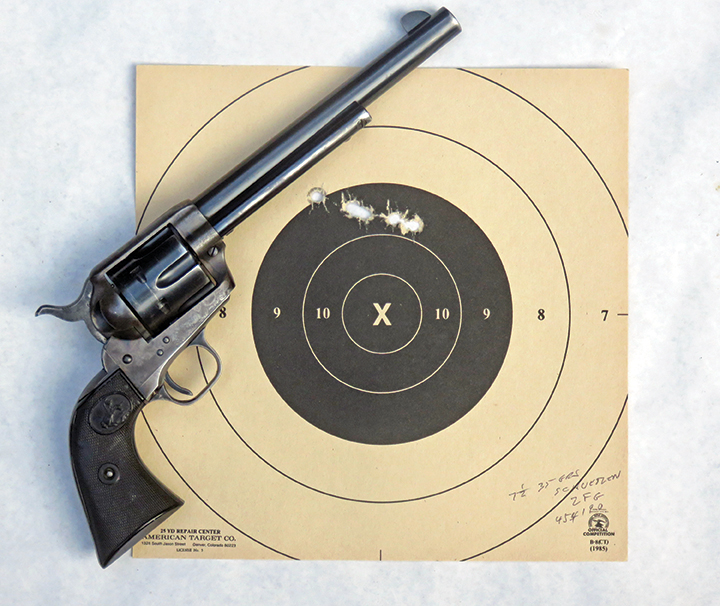
The 7½-inch barreled Colt did very well with 35 grains of Schuetzen 2Fg with the 260-grain bullet.
My expectations were overwhelmed quite a bit when the first shot was fired. What a roar! The velocity of that load was 1,018 fps! All five shots were fired and their average velocity was 992 feet per second. They even grouped rather well on the target. However, that load was on the extreme side and I do not recommend it. In my judgment, those loads exceeded everything in comfort, safety, and common sense. They were not used again.
The next load tried used the bullets from the same Lyman mould, but with a powder charge of 35 grains of Schuetzen 2Fg ignited by standard Large Pistol primers, loaded into the new Starline solid-head cases. Those loads were also on the heavy side, passing the chronograph screens at 952 feet per second a few feet beyond the end of my Colt’s 7½-inch barrel. Accuracy with that load was excellent and I could see using that load again in situations where power and accuracy were both desired. I say it in that way, because to me that load had more “bounce to the ounce” than was needed for a good target load.
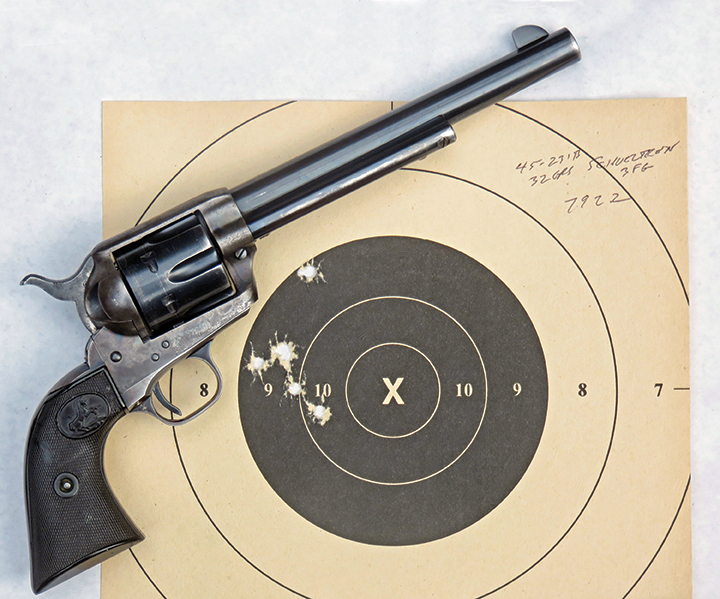
The 235-grain bullets over 32 grains of Schuetzen 3Fg were very pleasant.
That same load had an average velocity of 860 fps out of Jerry’s 5½-inch barreled gun, so perhaps it is in the realm of a good service load. Let me put it this way; 35 grains of the Schuetzen 2Fg powder under the 260-grain bullet is a serious load, to be used in serious situations. I do recommend it as a maximum black powder load when used in the modern solid-head cases.
Now, back to the slightly lighter loads which were mentioned previously. Those were our starting loads and we expected them to be on the light side. The 235-grain bullets from Accurate Molds’ No. 45-231B were simply great. I really recommend that bullet for the .45s, either in the longer Colt case or the 45 S&W. Out of my gun’s 7½-inch barrel, when powered by the 32 grains of Schuetzen 3Fg powder in the 45 Colt cases, the 235-grain bullets had a speed of 792 feet per second, the recoil level was very pleasant, but they had a wide spread of velocities. Out of Jerry’s 5½-inch barreled gun those same loads developed 681 fps and had an even wider velocity spread, which gave us a good start but those were not the best loads.
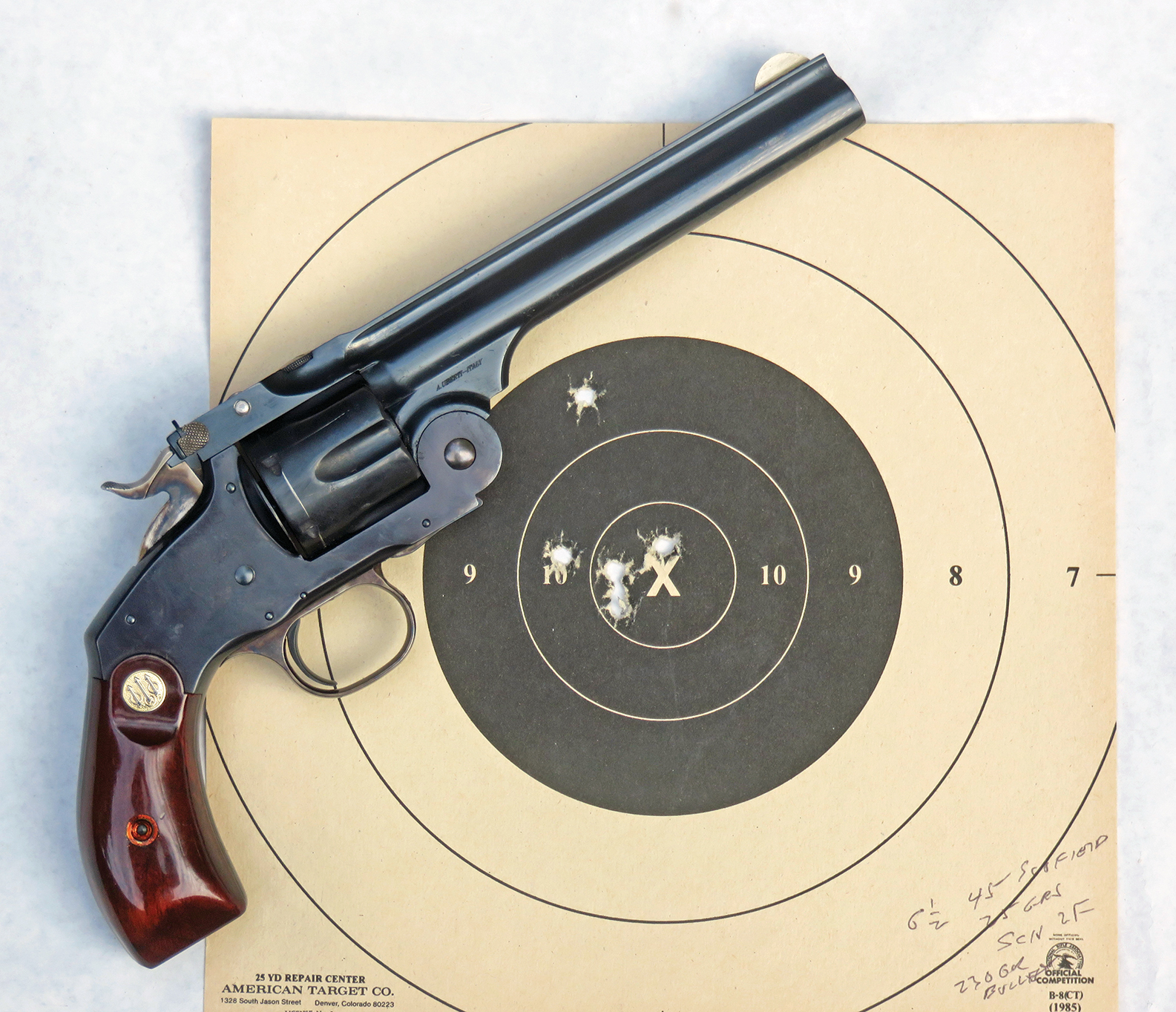
Our best shooting was done with the Schofield cases and 25 grains of Schuetzen 2Fg.
In the 45 Schofield cases, the same bullets over 22 grains of Schuetzen 3Fg developed 698 fps out of my gun’s 7½-inch barrel and was very pleasant to shoot. In the Uberti copy of the Smith & Wesson with the 6½-inch barrel, they averaged 644 fps and out of Jerry’s 5½-inch gun they averaged a very similar 642 feet per second. This just tells you where we started from.
Next, in the 45 Schofield cases, we loaded 25 grains of Schuetzen 2Fg under the 235-grain bullets and shot them in the copy of the Smith & Wesson, getting 668 feet per second. The real highlight of that load, other than its being so pleasant to shoot, was its accuracy. In our testing that load in that gun, it gave us our best group of all.
Those loads were also tried in Jerry’s 5½-inch barreled gun, getting just a slightly lower velocity of 652 feet per second. They weren’t tried in the 7½-inch Colt but they were shot in Bob DeLisle’s Ruger with a 45⁄8-inch barrel, getting an average of 666 feet per second. That just shows how barrel length is not the only influence for velocity.
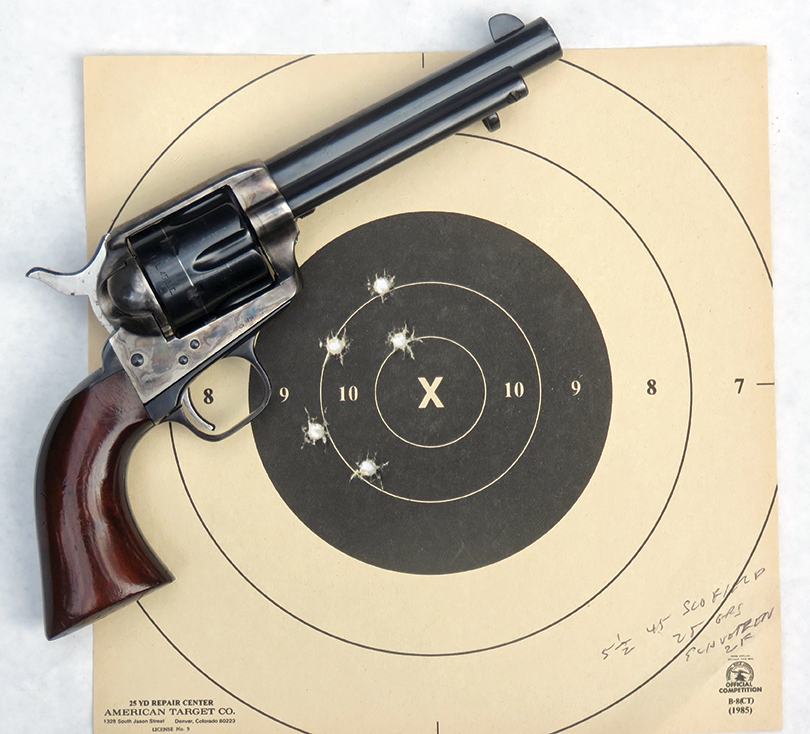
Jerry did very well shooting the 25-grain load in the Schofield cases.
While we actually did quite a bit of shooting to create this data, there were some gaps in our shooting. We never did fire any 45 Colt loads in the Uberti copy of the New Model No. 3 S&W. There was no technical reason for not using the 45 Colt loads in that gun and that is exactly what the replica is chambered for. Nonetheless, we felt more at home by using the 45 Schofield loads in that gun, as if it was an original, and the Schofield loads certainly did perform.
The last load tried in the 45 Colt cases will remain my favorite. That one used 33 grains of Swiss 2Fg powder under the 260-grain bullet, from Lyman’s No. 454190 mould. This sent that bullet across the chronograph screens at 911 feet per second out of my Colt’s 7½-inch barrel and was somewhat slower at 833 fps out of Jerry’s 5½-inch barreled gun. I’m just guessing that those velocities would be closer together if we were to test it again. In the other loads, that extra two inches of barrel length have made a big difference, so the almost 80 fps lost by the shorter gun is not beyond reason. This load will remain my favorite for its power, and when using my gun, it grouped very well.
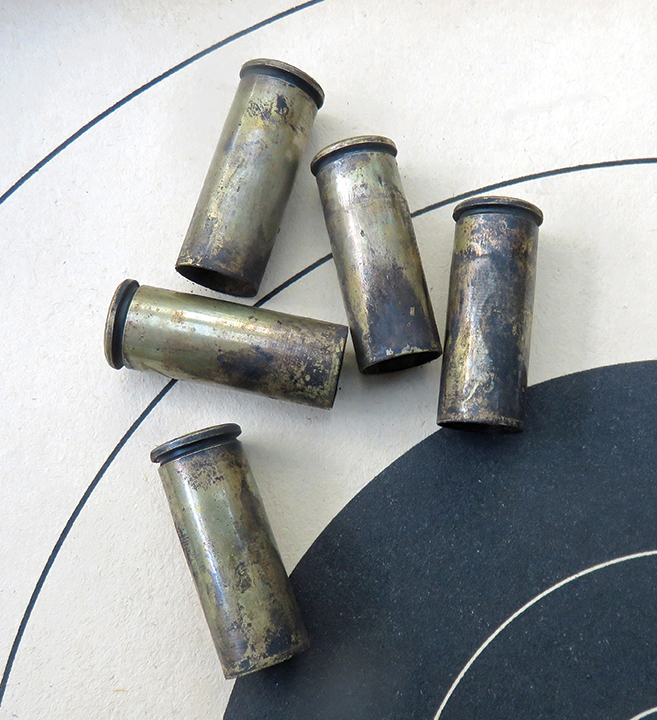
All of the black powder loads showed fouling blow-back on the fired brass
We found the Swiss 2Fg powder (25 grains) to be favored in the 45 Schofield brass with the 235-grain bullet as well. That was the top load tried in the shorter 45 S&W cases and it really stole the show when compared to the same powder charge of Schuetzen 2Fg by adding over 100 fps to the bullet’s velocity. This load will also be used again.
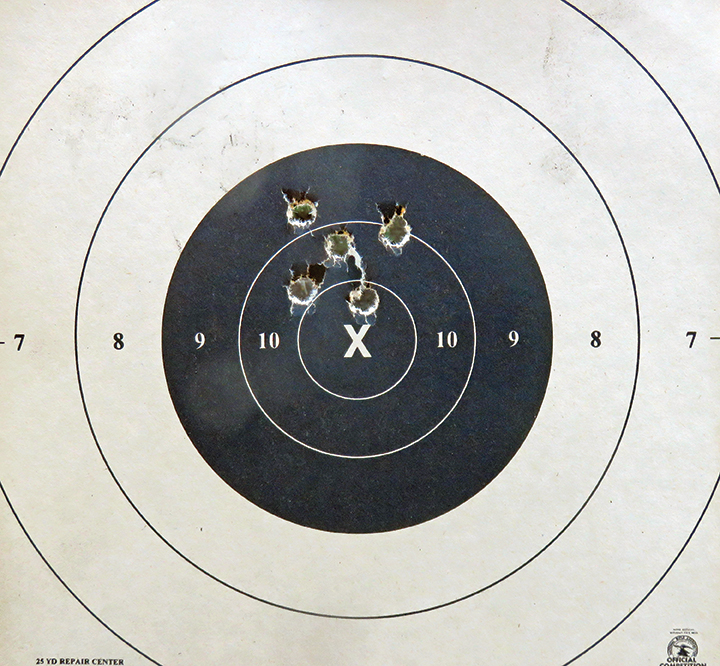
With accuracy like this, it’s easy to see why the 33 grains of Swiss 2Fg powder will remain a favorite load.
One load we didn’t try, which I realized only after looking at our own data chart, was to use the 235-grain bullet in the 45 Colt cases with a charge of Swiss 2Fg powder. We can easily assume that such a load would work very well, perhaps with the same 33-grain charge as used with the 260-grain bullets. My guess is that it will be tried, but not soon enough to make it here.
While our shooting with the various .45s didn’t actually discover anything new, we were able to put together some updated loads using the newer black powders. Those loads, as well as the targets, show there is still plenty of life left in the old .45s and they can still pack the power that made them famous. And, with black powder loads, there’s still plenty of smoke from the old .45!












